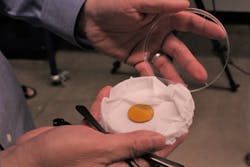University of Arizona group uses computational chemistry to find new material for cheaper polymer IR lenses
University of Arizona materials scientist Jeffrey Pyun and his colleagues are known for their creation of inexpensive polymer IR lenses using sulfur left over from refining fossil fuels; now the team has improved the material, devising new polymers that are are stronger and more temperature-resistant than the first-generation sulfur plastic developed in 2014 that was transparent to mid-IR wavelengths.1
The new high-refractive-index chalcogenide hybrid inorganic/organic polymers (CHIPs) lenses are transparent to a wider spectral window extending into the long‐wave IR (LWIR) region (7–14 μm) and are far less expensive than the current industry standard of lenses made of germanium, which is expensive, heavy, rare, and toxic.
“IR imaging technology is already used extensively for military applications such as night vision and heat-seeking missiles,” says Pyun, a professor in the Department of Chemistry and Biochemistry who leads the lab that developed the polymer. “But for consumers and the transportation sector, cost limits high-volume production of this technology.”
The new lens material could make IR cameras and sensor devices more accessible to consumers, according to optical scientist Robert Norwood,, a professor in the James C. Wyant College of Optical Sciences. Potential consumer applications include economical autonomous vehicles and in-home thermal imaging for security or fire protection.
Because of germanium’s many drawbacks, Tristan Kleine, a graduate student in Puyn’s lab and first author on the paper, identified a sulfur-based plastic as an attractive alternative. But the components that give rise to useful optical properties, such as sulfur-sulfur bonds, also compromise the strength and temperature resistance of the material. Moreover, the inclusion of additional organic molecules to give the material strength resulted in reduced transparency, since nearly all organic molecules absorb IR light, Kleine says.
Computational simulation
To overcome the challenge, Kleine, in collaboration with chemistry graduate student Meghan Talbot and chemistry and biochemistry professor Dennis Lichtenberger, used computational simulation to design organic molecules that are not IR-absorbing and predicted transparency of candidate materials.
“A major advantage of these new sulfur-based plastics is the ability to readily process these materials at much lower temperatures than germanium into useful optical elements for cameras or sensors, while still maintaining good thermomechanical properties to prevent cracking or scratches,” Pyun says. “This new material has just checked so many boxes we couldn’t before.”
“Its reliability is essentially equivalent to optical polymers that are routinely used for eyeglasses,” Norwood adds.
The team is partnering with Tech Launch Arizona to translate the research into a viable technology.
Researchers from the University of Delaware and Seoul National University also contributed to the research.
Source: https://uanews.arizona.edu/story/using-computational-chemistry-produce-cheaper-infrared-plastic-lenses
REFERENCE:
1. Tristan S. Kleine et al., Angewandte Chemie (2019); https://doi.org/10.1002/ange.201910856.
About the Author
John Wallace
Senior Technical Editor (1998-2022)
John Wallace was with Laser Focus World for nearly 25 years, retiring in late June 2022. He obtained a bachelor's degree in mechanical engineering and physics at Rutgers University and a master's in optical engineering at the University of Rochester. Before becoming an editor, John worked as an engineer at RCA, Exxon, Eastman Kodak, and GCA Corporation.

